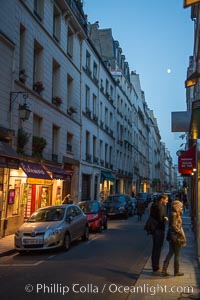
Ile Saint-Louis, is one of two natural islands in the Seine river, in Paris, France. The island is named after King Louis IX of France (Saint Louis). The island is connected to the rest of Paris by bridges to both banks of the river and by the Pont Saint Louis to the Ile de la Cite.
Location: Ile Saint-Louis, Paris, France
Image ID: 28245
Location: Ile Saint-Louis, Paris, France
Image ID: 28245

Ile Saint-Louis, is one of two natural islands in the Seine river, in Paris, France. The island is named after King Louis IX of France (Saint Louis). The island is connected to the rest of Paris by bridges to both banks of the river and by the Pont Saint Louis to the Ile de la Cite.
Location: Ile Saint-Louis, Paris, France
Image ID: 28253
Location: Ile Saint-Louis, Paris, France
Image ID: 28253
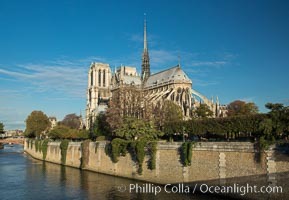
Notre Dame de Paris. Notre Dame de Paris ("Our Lady of Paris"), also known as Notre Dame Cathedral or simply Notre Dame, is a historic Roman Catholic Marian cathedral on the eastern half of the Ile de la Cite in the fourth arrondissement of Paris, France. Widely considered one of the finest examples of French Gothic architecture and among the largest and most well-known churches in the world ever built, Notre Dame is the cathedral of the Catholic Archdiocese of Paris.
Location: Notre Dame de Paris, France
Image ID: 28255
Location: Notre Dame de Paris, France
Image ID: 28255
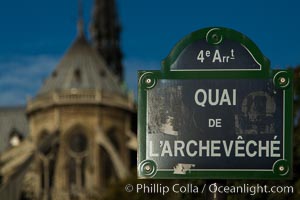
Notre Dame de Paris. Notre Dame de Paris ("Our Lady of Paris"), also known as Notre Dame Cathedral or simply Notre Dame, is a historic Roman Catholic Marian cathedral on the eastern half of the Ile de la Cite in the fourth arrondissement of Paris, France. Widely considered one of the finest examples of French Gothic architecture and among the largest and most well-known churches in the world ever built, Notre Dame is the cathedral of the Catholic Archdiocese of Paris.
Location: Notre Dame de Paris, France
Image ID: 28257
Location: Notre Dame de Paris, France
Image ID: 28257
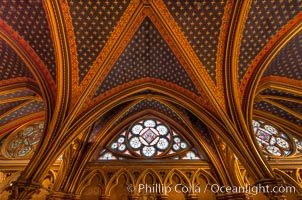
La Sainte-Chapelle, The Holy Chapel, is one of the only surviving buildings of the Capetian royal palace on the Ile de la Cite in the heart of Paris, France. It was commissioned by King Louis IX of France to house his collection of Passion Relics, including the Crown of Thorns - one of the most important relics in medieval Christendom.
Location: La Sainte-Chapelle, Paris, France
Image ID: 28033
Location: La Sainte-Chapelle, Paris, France
Image ID: 28033
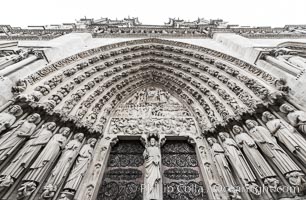
Notre Dame de Paris. Notre Dame de Paris ("Our Lady of Paris"), also known as Notre Dame Cathedral or simply Notre Dame, is a historic Roman Catholic Marian cathedral on the eastern half of the Ile de la Cite in the fourth arrondissement of Paris, France. Widely considered one of the finest examples of French Gothic architecture and among the largest and most well-known churches in the world ever built, Notre Dame is the cathedral of the Catholic Archdiocese of Paris.
Location: Notre Dame de Paris, France
Image ID: 28128
Location: Notre Dame de Paris, France
Image ID: 28128
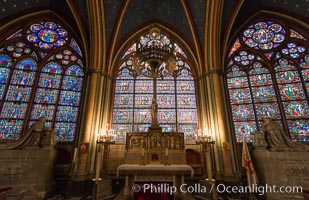
Notre Dame de Paris. Notre Dame de Paris ("Our Lady of Paris"), also known as Notre Dame Cathedral or simply Notre Dame, is a historic Roman Catholic Marian cathedral on the eastern half of the Ile de la Cite in the fourth arrondissement of Paris, France. Widely considered one of the finest examples of French Gothic architecture and among the largest and most well-known churches in the world ever built, Notre Dame is the cathedral of the Catholic Archdiocese of Paris.
Location: Notre Dame de Paris, France
Image ID: 28129
Location: Notre Dame de Paris, France
Image ID: 28129
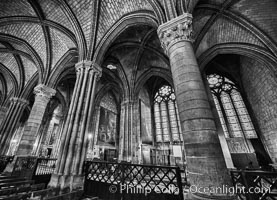
Notre Dame de Paris. Notre Dame de Paris ("Our Lady of Paris"), also known as Notre Dame Cathedral or simply Notre Dame, is a historic Roman Catholic Marian cathedral on the eastern half of the Ile de la Cite in the fourth arrondissement of Paris, France. Widely considered one of the finest examples of French Gothic architecture and among the largest and most well-known churches in the world ever built, Notre Dame is the cathedral of the Catholic Archdiocese of Paris.
Location: Notre Dame de Paris, France
Image ID: 28130
Location: Notre Dame de Paris, France
Image ID: 28130
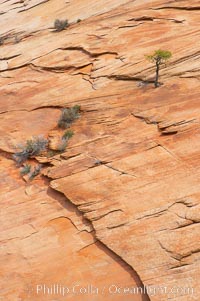
Navajo sandstone forms the cliffs and walls of Zion National Park. The sandstone reaches a thickness of 2300 feet and consists of ancient cemented desert sand dunes. Horizontal lines, commonly called crossbedding, represent layers of wind-blown sand that built up into sand dunes. These dunes were then buried, and the sand grains glued together by calcite and iron oxide to form sandstone.
Location: Zion National Park, Utah
Image ID: 12514
Location: Zion National Park, Utah
Image ID: 12514
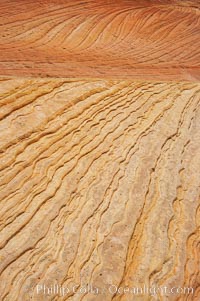
Navajo sandstone forms the cliffs and walls of Zion National Park. The sandstone reaches a thickness of 2300 feet and consists of ancient cemented desert sand dunes. Horizontal lines, commonly called crossbedding, represent layers of wind-blown sand that built up into sand dunes. These dunes were then buried, and the sand grains glued together by calcite and iron oxide to form sandstone.
Location: Zion National Park, Utah
Image ID: 12515
Location: Zion National Park, Utah
Image ID: 12515
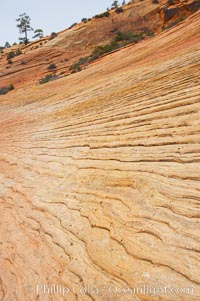
Navajo sandstone forms the cliffs and walls of Zion National Park. The sandstone reaches a thickness of 2300 feet and consists of ancient cemented desert sand dunes. Horizontal lines, commonly called crossbedding, represent layers of wind-blown sand that built up into sand dunes. These dunes were then buried, and the sand grains glued together by calcite and iron oxide to form sandstone.
Location: Zion National Park, Utah
Image ID: 12516
Location: Zion National Park, Utah
Image ID: 12516
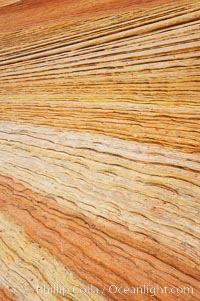
Navajo sandstone forms the cliffs and walls of Zion National Park. The sandstone reaches a thickness of 2300 feet and consists of ancient cemented desert sand dunes. Horizontal lines, commonly called crossbedding, represent layers of wind-blown sand that built up into sand dunes. These dunes were then buried, and the sand grains glued together by calcite and iron oxide to form sandstone.
Location: Zion National Park, Utah
Image ID: 12517
Location: Zion National Park, Utah
Image ID: 12517
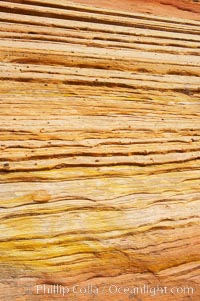
Navajo sandstone forms the cliffs and walls of Zion National Park. The sandstone reaches a thickness of 2300 feet and consists of ancient cemented desert sand dunes. Horizontal lines, commonly called crossbedding, represent layers of wind-blown sand that built up into sand dunes. These dunes were then buried, and the sand grains glued together by calcite and iron oxide to form sandstone.
Location: Zion National Park, Utah
Image ID: 12518
Location: Zion National Park, Utah
Image ID: 12518
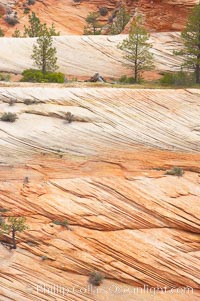
Navajo sandstone forms the cliffs and walls of Zion National Park. The sandstone reaches a thickness of 2300 feet and consists of ancient cemented desert sand dunes. Horizontal lines, commonly called crossbedding, represent layers of wind-blown sand that built up into sand dunes. These dunes were then buried, and the sand grains glued together by calcite and iron oxide to form sandstone.
Location: Zion National Park, Utah
Image ID: 12520
Location: Zion National Park, Utah
Image ID: 12520
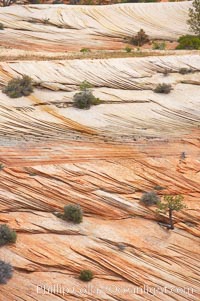
Navajo sandstone forms the cliffs and walls of Zion National Park. The sandstone reaches a thickness of 2300 feet and consists of ancient cemented desert sand dunes. Horizontal lines, commonly called crossbedding, represent layers of wind-blown sand that built up into sand dunes. These dunes were then buried, and the sand grains glued together by calcite and iron oxide to form sandstone.
Location: Zion National Park, Utah
Image ID: 12521
Location: Zion National Park, Utah
Image ID: 12521
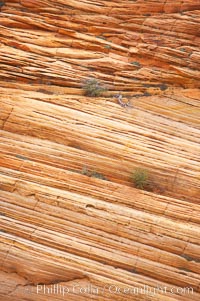
Navajo sandstone forms the cliffs and walls of Zion National Park. The sandstone reaches a thickness of 2300 feet and consists of ancient cemented desert sand dunes. Horizontal lines, commonly called crossbedding, represent layers of wind-blown sand that built up into sand dunes. These dunes were then buried, and the sand grains glued together by calcite and iron oxide to form sandstone.
Location: Zion National Park, Utah
Image ID: 12522
Location: Zion National Park, Utah
Image ID: 12522
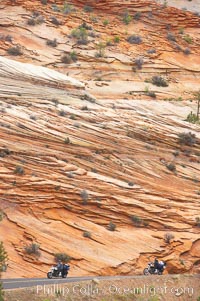
Navajo sandstone forms the cliffs and walls of Zion National Park. The sandstone reaches a thickness of 2300 feet and consists of ancient cemented desert sand dunes. Horizontal lines, commonly called crossbedding, represent layers of wind-blown sand that built up into sand dunes. These dunes were then buried, and the sand grains glued together by calcite and iron oxide to form sandstone.
Location: Zion National Park, Utah
Image ID: 12523
Location: Zion National Park, Utah
Image ID: 12523
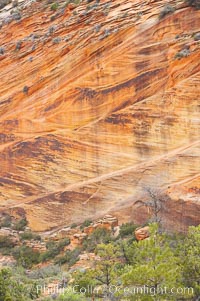
Navajo sandstone forms the cliffs and walls of Zion National Park. The sandstone reaches a thickness of 2300 feet and consists of ancient cemented desert sand dunes. Horizontal lines, commonly called crossbedding, represent layers of wind-blown sand that built up into sand dunes. These dunes were then buried, and the sand grains glued together by calcite and iron oxide to form sandstone.
Location: Zion National Park, Utah
Image ID: 12524
Location: Zion National Park, Utah
Image ID: 12524
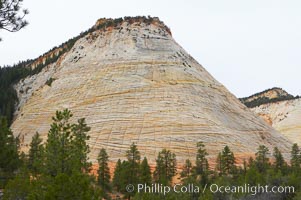
Checkerboard Mesa, a good example of crossbedding (horizontal lines) and vertical cracks caused by thermal expansion/contraction. Navajo sandstone forms the cliffs and walls of Zion National Park. The sandstone reaches a thickness of 2300 feet and consists of ancient cemented desert sand dunes. Horizontal lines, commonly called crossbedding, represent layers of wind-blown sand that built up into sand dunes. These dunes were then buried, and the sand grains glued together by calcite and iron oxide to form sandstone.
Location: Zion National Park, Utah
Image ID: 12526
Location: Zion National Park, Utah
Image ID: 12526
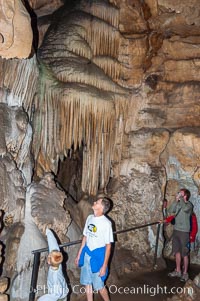
Visitors admire the Pipe Organ formation of calcite flowstone and cave curtains.
Location: Crystal Cave, Sequoia Kings Canyon National Park, California
Image ID: 09910
Location: Crystal Cave, Sequoia Kings Canyon National Park, California
Image ID: 09910
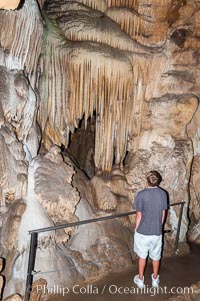
Visitors admire the Pipe Organ formation of calcite flowstone and cave curtains.
Location: Crystal Cave, Sequoia Kings Canyon National Park, California
Image ID: 09911
Location: Crystal Cave, Sequoia Kings Canyon National Park, California
Image ID: 09911
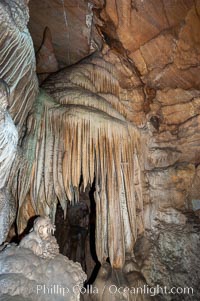
The Pipe Organ, a formation of calcite flowstone and cave curtains.
Location: Crystal Cave, Sequoia Kings Canyon National Park, California
Image ID: 09912
Location: Crystal Cave, Sequoia Kings Canyon National Park, California
Image ID: 09912
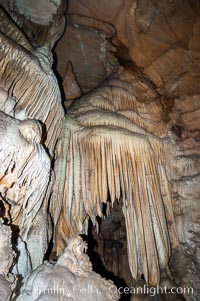
The Pipe Organ, a formation of calcite flowstone and cave curtains.
Location: Crystal Cave, Sequoia Kings Canyon National Park, California
Image ID: 09913
Location: Crystal Cave, Sequoia Kings Canyon National Park, California
Image ID: 09913
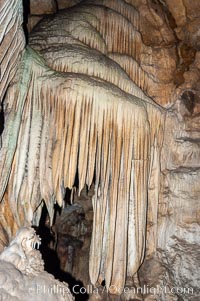
The Pipe Organ, a formation of calcite flowstone and cave curtains.
Location: Crystal Cave, Sequoia Kings Canyon National Park, California
Image ID: 09914
Location: Crystal Cave, Sequoia Kings Canyon National Park, California
Image ID: 09914
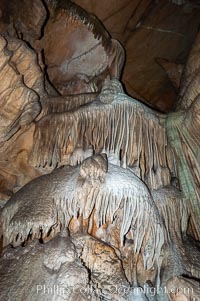
Calcite flowstone and cave curtains.
Location: Crystal Cave, Sequoia Kings Canyon National Park, California
Image ID: 09915
Location: Crystal Cave, Sequoia Kings Canyon National Park, California
Image ID: 09915
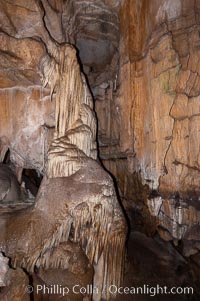
Calcite flowstone and cave curtains.
Location: Crystal Cave, Sequoia Kings Canyon National Park, California
Image ID: 09916
Location: Crystal Cave, Sequoia Kings Canyon National Park, California
Image ID: 09916
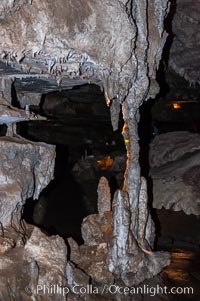
Calcite stalactites hanging from above have joined with stalagmites growing on the cave floor to form a solid column.
Location: Crystal Cave, Sequoia Kings Canyon National Park, California
Image ID: 09922
Location: Crystal Cave, Sequoia Kings Canyon National Park, California
Image ID: 09922
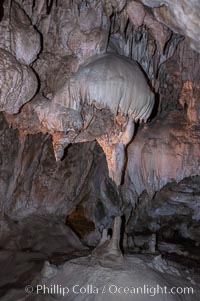
Calcite stalactites and stalagmites.
Location: Crystal Cave, Sequoia Kings Canyon National Park, California
Image ID: 09923
Location: Crystal Cave, Sequoia Kings Canyon National Park, California
Image ID: 09923
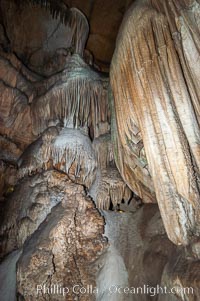
Calcite stalactites and stalagmites.
Location: Crystal Cave, Sequoia Kings Canyon National Park, California
Image ID: 09924
Location: Crystal Cave, Sequoia Kings Canyon National Park, California
Image ID: 09924
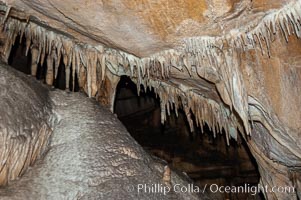
Calcite stalactites and stalagmites.
Location: Crystal Cave, Sequoia Kings Canyon National Park, California
Image ID: 09925
Location: Crystal Cave, Sequoia Kings Canyon National Park, California
Image ID: 09925